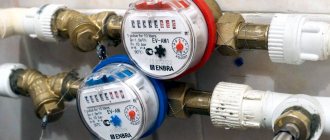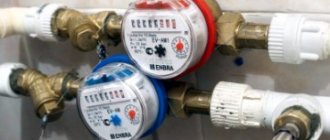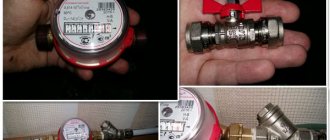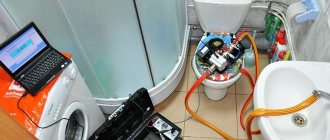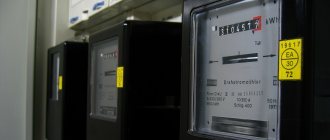Currently, a significant share of citizens' expenses is made up of housing and communal services, the lion's share of which relates to payment of bills for supplied heat.
Dear readers! Our articles talk about typical ways to resolve legal issues, but each case is unique. If you want to find out how to solve your particular problem, please use the online consultant form on the right or call. It's fast and free!
To save money, you can carry out a set of energy-saving measures, but they will not protect against energy losses during its delivery. The best solution to this issue is the acquisition and commissioning of thermal energy meters.
Why do we need public metering devices?
In order to keep accurate records and obtain actual consumption indicators, it is necessary to install a collective meter. In the absence of such a device, payment is made based on the tariff per 1 sq. m. for a month. This indicator is made up of averaged, imprecise components.
- From July 1, 2012, Federal Law No. 261 of November 23, 2009 required the installation of collective and individual heat energy meters in apartment buildings.
- Since 2020, for those who do not have them, invoices began to be issued with an additional increasing factor to the tariffs, and payments have increased significantly. This prompted homeowners to install collective metering devices.
A common house appliance is needed not only for the fair distribution of payments by each individual tenant, but also the responsibility for saving thermal resources increases. Such events include:
- insulation of the facade of the house;
- purchase of new double-glazed windows for entrances;
- sealing doors, windows;
- replacement and flushing of heating system pipes to prevent leaks and accidents;
- installation of doors in attic and basement openings.
Is a communal meter needed if apartments have individual metering devices?
In order not to depend on your neighbors, you can purchase an individual meter. In houses built before 2000, this is unprofitable. The heating system is such that a meter will have to be installed on each radiator. This will lead to large financial costs.
Good to know! The functioning of an individual meter does not cancel out the general house meter, which shows the heat consumption of not only residential premises, but also heated entrances, basements, and attics.
Heating meter for apartment
The current tariff schedule for heating payments obliges residents to pay not for the kilowatts spent, but for the heated meters. It does not take into account whether there is heat in the room or not. This situation does not suit an increasing number of people.
There is still debate about how economically beneficial a heating meter is for an apartment, the legality of this procedure and its feasibility.
How to install a heating meter in an apartment?
As many years of practice have shown in installing heating meters in apartments, several nuances need to be taken into account:
- First of all, the heating circuit diagram is important. Thus, in houses that are more than 20 years old, vertical distribution of heating pipes is mainly found, which means that there are several risers in all rooms at once. As a rule, installing heat meters for heating in an apartment building with such a circuit is either impossible or incredibly expensive, since measuring equipment will have to be installed on each riser. In new generation apartment buildings, horizontal wiring is used, in which one riser runs to each apartment. With such a system, there are no legal prohibitions on installing the meter.
- To install a meter, you will need appropriate permission from the organization supplying heat to the house. It must indicate all the technical parameters of the heating system of an apartment building, according to which the measuring device will be selected.
- The purchased meter must be presented for evaluation by the regulatory authority , which will register it.
- Representatives of organizations that have the appropriate permission to do so are required to install heat meters for heating in apartments .
Many consumers wonder how profitable all this effort and financial investment is, and how quickly the costs will pay off. There is no definite answer, since even if the heat in the apartment is regulated and it is saved significantly, its residents will be required to pay for heating the common area - the entrance, the basement, if there is one, the staircase.
The only thing that benefits the heat consumer when the meter is running is the ability to turn off heating in rooms where it is not needed. In this case, costs are significantly reduced, which will immediately be reflected in the payment document.
There is no need to install individual heating meters in an apartment if it has not had additional thermal insulation, for example, on the floor or walls, especially if they are external.
How to install communal heat meters?
Article 13 of Federal Law No. 261 of November 23, 2009 states that metering devices are not used in dilapidated, emergency housing awaiting major repairs or demolition. The article applies to facilities where the power consumption of electrical energy is less than five kilowatts.
To summarize, the meter is not installed where it is impossible for technical reasons and is not economically feasible.
In all other cases, it is necessary to meter thermal energy using collective devices.
Let's look at two truly working ways to install metering devices:
- Homeowners.
- Energy supply company.
Installation of the device by homeowners
First of all, the owners organize a meeting where the following issues are discussed and accepted for execution:
- about the installation of the meter, cost, payment procedure;
- on obtaining technical specifications for the installation from the heat supply organization;
- on holding a tender to select a contractor, concluding an agreement for installation, maintenance of the meter, introducing these costs into the housing maintenance tariff;
- select an authorized person.
The selected representative enters into an agreement for the installation and maintenance of the metering device.
The company installs it and registers it.
Good to know! The authorized person signs the acceptance certificate for the work performed and makes payment. The agreement between the homeowners' association and the heating network is being changed in terms of the method of payment based on fact, and not according to the standard.
Features of the meeting:
- The meeting is considered legal when the residents were warned in advance (at least 10 days in advance), and decisions were made if more than 50 percent voted for them.
- The tender is carried out with the obligatory request of estimates with justification of the costs of performing the upcoming work from each company. To avoid unnecessary expenses, estimates need to be checked. The contractor is selected with the most acceptable and optimal prices. The reputation of the company and its reliability play a big role in choosing a contractor.
Installation of the device by the energy supply company
The first step is for homeowners to contact the heat supply organization (hereinafter referred to as the organization) with the question of purchasing and installing a meter.
wpmfc_cab_ss] Let's celebrate! If the answer is positive, it reflects the cost and timing of installation of the meter. If the issue is refused, the motives are indicated and the reasons are explained. If you are dissatisfied with the decision, you can write a complaint to the antimonopoly service in your region.[/wpmfc_cab_ss]
The next step is the installation of a metering device by the organization.
At the meeting, it is established who will carry out the maintenance, and payment for this work occurs.
Who pays for the installation?
All costs for installing and maintaining the meter are paid by the homeowners. The share of the fee is calculated in proportion to the square footage of the premises occupied by the owner from the total area of the house. You can reimburse your expenses in one go by paying the entire amount.
Another option could be an installment plan for 5 years. In this case, the monthly payment will be billed for 5 years with an increase in the amount of interest in effect on the accrual date.
Based on the fact that collective meters are common property, expenses for routine maintenance, verification of serviceability, and repair of metering devices should be planned in the cost estimate of an apartment building.
Accordingly, the fee for the maintenance of meters will be billed in the invoice column - maintenance and repair of common property. It is not allowed to separate out the fee for repair and verification of the metering device as a separate line item.
Good to know! If contributions for major repairs are accumulated in a special account of your home, then you can use it to pay for the purchase and commissioning of a heating unit. If residents pay for major repairs to the general fund of the region, then such a purchase is possible only when the time for repairing the high-rise building approaches.
Advantages and disadvantages of common house heat metering devices
The advantages of meters are undeniable. By taking inventory and modernizing heating networks and implementing energy saving measures, you can save up to 40 percent on heating energy payments.
Despite all the advantages, collective meters have the following disadvantages:
- The high cost of the metering device, its installation and configuration. The price ranges from 150 thousand to 1 million rubles.
- Payment is made by all homeowners. In the event that a tenant disagrees, but at the meeting a decision on installation was made by a majority vote, he is also obliged to take part in reimbursing the costs. If they refuse to pay, the necessary amounts will be collected from such owners through the judicial authorities.
- Disagreements among residents regarding the heating of common areas.
- Additional costs if the contractor fails to comply with the terms of the contract. With irregular, unscrupulous maintenance of metering devices, the number of repairs increases and the service life of the heat meter decreases.
In conclusion, I would like to say! Despite the cost and other negative factors, it is more economically feasible and profitable to meter heat consumption using collective metering devices.
Didn't find the answer to your question? Find out how to solve exactly your problem - call right now: +7 (Moscow) +7 (812) 309-53-42 (St. Petersburg) It's fast and free!
Choosing a heat meter for an apartment building
Heat meters in an apartment building must meet a number of requirements. Technical conditions for using such a device include:
- temperature graph;
- thermal load;
- design pressure;
- maximum coolant flow;
- configuration
Our specialists take a responsible approach to choosing a device and are always ready to advise which heating meter to choose for an apartment building.
Installing a meter on a house requires the investment of all residents. Despite the difficulties associated with raising money, the purchase price should be carefully considered and do not try to save money on equipment! After all, from the first months after installation, the heat meter will begin to save your money and will quickly pay back the costs of its installation!!! Our many years of experience show that a cheap meter may not last the promised service life, and as a result, you will have to start the fundraising process all over again. Installing a meter in an apartment building will pay for itself over time only if the device is of high quality.
Thanks to the consultation of our specialists, you can easily choose a meter model that suits you in terms of price and quality.
carries out installation work during the day. An important condition that our craftsmen adhere to is the appropriate temperature, which does not fall below –10 °C.
After completing the installation work, we invite a heat supply inspector who controls and seals the meter. Thanks to the well-coordinated operational work of our craftsmen, installing a heat meter in your home will not take much of your time, and soon you will be able to start using it and saving money.
Prices for work:
For individuals For legal entities
A large fleet allows you to reduce your costs

